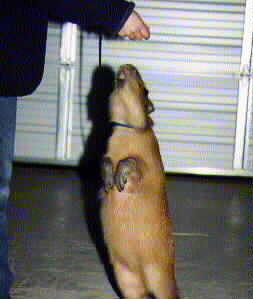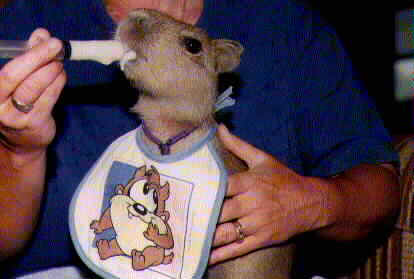Capybara
Don't you think capybara look like giant smooth-coated guinea
pigs?
They live in and near the fresh water
lakes and marshes of Central and South America.
Order: Rodentia
Family: Hydrochaeridae
Genus: Hydrochaeris
Species: Hydrochaeris
Capybaras are the largest member of the order of rodents and can tip the
scale at 150 to 200 lb. They resemble a huge smooth-coated guinea pig to
which they are closely related. They are also called 'water-hogs'.
Capybara have a large guinea pig shaped body, with a large head that ends
in a rectangular, blunt muzzle and a heavy upper lip. They have small, rounded
ears, which along with their nostrils can be sealed when they are in or
under the water. Capybara are avid swimmers and have partially webbed feet
to aid in movement in the water.
Mating is year round, however mostly occurs in April and May and again in
the fall. Most females have one litter per year, although two litters are
not uncommon. Females have 5 pair of mammae and have litters of 2-8, averaging
5 babies. Gestation is 120-150 days. With babies weighing 3 lb. The young
can follow the mother from birth and reach sexual maturity at 15 months.
They can live up to 12 years in captivity. Capybara often defecate in the
water and most mating takes place in water.
In the wild, the capybara likes to shelter and hide in thick brush. In totally
wild habitat, it is active in the day but where it is bothered by people,
it has become nocturnal or crepuscular. The capybara is hunted by farmers
for meat and hides and to protect agricultural crops. Its teeth are prized
as ornaments by natives and the body fat is used in pharmaceuticals. In
some areas it is becoming rare, while in other areas it thrives. Some ranchers
with marginal land for cattle because of excessive wetlands, have begun
to farm capybara as livestock.
It can run with similar gait to a horse. It is equally or more at home in
the water when in danger and swims with its eyes and nose above water. It
can swim great distances under water or lay nearly totally submerged in
water vegetation. In the wild its diet consists of grasses, water plants
and vegetables. They are usually found in herds of 20 or more animals and
groups of 100 have been sighted.
These animals are capable of various sounds including grunts, barks, clicks
and whistles.
In captivity
Capybara can make captivating pets, but it is our unanimous opinion that
a PET capybara should be neutered. Males can become aggressive, territorial
and frustrated. They may even make you the object of their 'affection',
not a pleasant thought when you are showing off your little "fella" to a
visitor. Neutering should take place before adulthood, preferably around
6-9 months of age.
Capybara can be taught some tricks and how to walk on a leash.
These can be trained to do various tricks for food rewards. They can be
affectionate and extremely clean in their toilet habits. Young capybara
can become very tame, and can be trained to walk on a leash like a dog.
A flat nylon choke type collar works the best. They are very receptive to
'neck corrections' but they move slowly and deliberately. Do not expect
a fast paced hike when working with them. You can teach them tricks, such
as sitting up to beg, climbing stairs, and more.
Enclosures for captive animals should be strong enough, especially where
the fence meets the ground to prevent escape. Although they are touted to
be avid diggers, ours have NEVER dug anywhere in their pen. We provide them
with houses, mounds of grass hay to nest in and a tub of water to bathe
and breed in. Fences can be of 2" x 4" mesh, and 3-4 feet high are sufficient.
They must have places to hide, get out of the sun and snooze.
Our capybara are our garbage disposals. They get all the peelings and seeds
from the fruits and vegetables left over from the other animals. That is
supplemented with fresh grass hay, rabbit chow, and brood mare pellets.
They are healthy, happy animals. Here are some other diets geared to an
adult animal.
Diet #1: Free choice grass hay, 1-2 apples, 1-2 carrots or yams, 2
cups. Monkey chow, 1 head romaine lettuce or endive
Diet #2: 1 cup horse chow, 1 cup rodent chow, Free choice alfalfa
hay, « head lettuce, 1 apples, 1 carrot, 1 sweet potato, free choice
grass hay.
Diet #3: 1 head lettuce, 1 oranges, 1 cups rodent lab chow, 1 apples,
1 carrots, 1 cup rabbit chow, free choice grass hay.
Diet #4: Purina Lagomorph Diet, Purina Zoo "A" Diet, Purina Browser
and free-fed grass hay.
We hesitate to list quantities because individuals vary according to size,
sex, maturity, activity level, stage of pregnancy or lactation. Use this
only as a guide, and monitor the animals weight and appetite. If the animal
is gaining too much weight, reduce the portion of food across the board,
not one or two items. Pregnant or nursing mothers will need a larger portion,
sometimes 2-3 times the normal diet for that individual.
In addition to the normal diet, all rodents MUST have something non-toxic
to chew on such as willow or birch branches. Check with your county extension
agent or poison control center if you wish to feed branches from trees you
do not know are absolutely safe. If they do not have chews, their teeth
will not wear down properly and can grow extremely long causing injury to
the roof of their mouth and other mouth parts.
Charmin loves her ba-ba but does NOT like to be squeezed
Infants can be hand-reared using Esbilac with added vitamins. They should
be kept at 75 degrees F. Feed every three hours until 3 weeks old, day and
night. The next two weeks increase feedings, and decrease number of times
per day, eliminating night feedings. From three days of age, offer solids
including grass hay, romaine lettuce, grains and fruits. When eating well,
at about 16 weeks, eliminate milk.
R-Zu-2-U Home
R-Zu-2-U FAQs
R-Zu-2-U Animal "Terms"
Treasure Ranch Home



